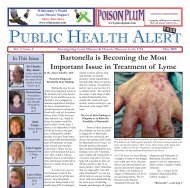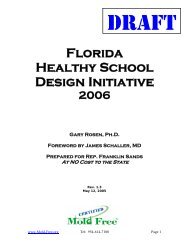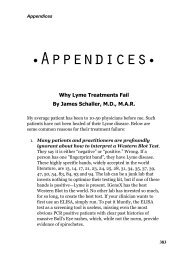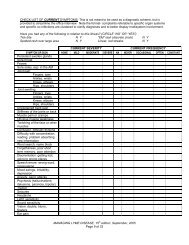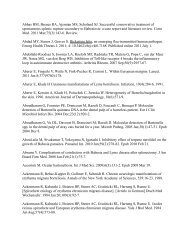Download Here - James L. Schaller, M.D., M.A.R., P.C
Download Here - James L. Schaller, M.D., M.A.R., P.C
Download Here - James L. Schaller, M.D., M.A.R., P.C
Create successful ePaper yourself
Turn your PDF publications into a flip-book with our unique Google optimized e-Paper software.
Environmentally Friendly Mold Remediation Techniques That Significantly Reduce Childhood Asthma6. Evaluating Cause and Extent of the Mold GrowthInvestigationCause of Mold GrowthCorrecting a mold problem requires understanding the extent of theproblem and the underlying causes. In some cases, this is fairly simple,such as when an obvious moisture source has affected only a limitedarea resulting in easily observable (visible) mold. However, correctinga problem can be difficult when the source(s) of moisture, theinteraction with building conditions, or the location(s) of the moldgrowth are not readily apparent.When the mold problem is relatively straightforward and can becorrected through routine custodial practices, it should be remediatedas promptly as health and safety practices and procedures allow.When a complex mold problem exists, assess the situation thoroughlyand objectively before beginning remediation. Resist the temptationto address only the easiest, most obvious evidence of contaminationwithout looking for hidden growth or reservoirs of contamination. Toachieve a durable and effective solution, it is imperative to understandthe cause of the moisture problem(s). Knowing the source of theexcess moisture is vital to correcting and preventing recurrence of theproblem. Identifying the pathways the moisture may have taken canhelp locate hidden mold growth.The success of remediating a mold problem ultimately depends onhow well the underlying moisture and contamination problems areunderstood. If a remediation plan relies heavily on reports of pastinvestigations, the accuracy and completeness of those efforts shouldbe objectively assessed. Review the findings of the reports and evaluatehow completely the important issues were assessed. But do not assumethat past findings necessarily reflect current conditions. Considerwhether the conclusions and recommendations are logical in light ofall available information, especially any recent findings.When moisture problems or contamination are extensive, conduct aninformed and thorough inspection of not only the affected area, but53





